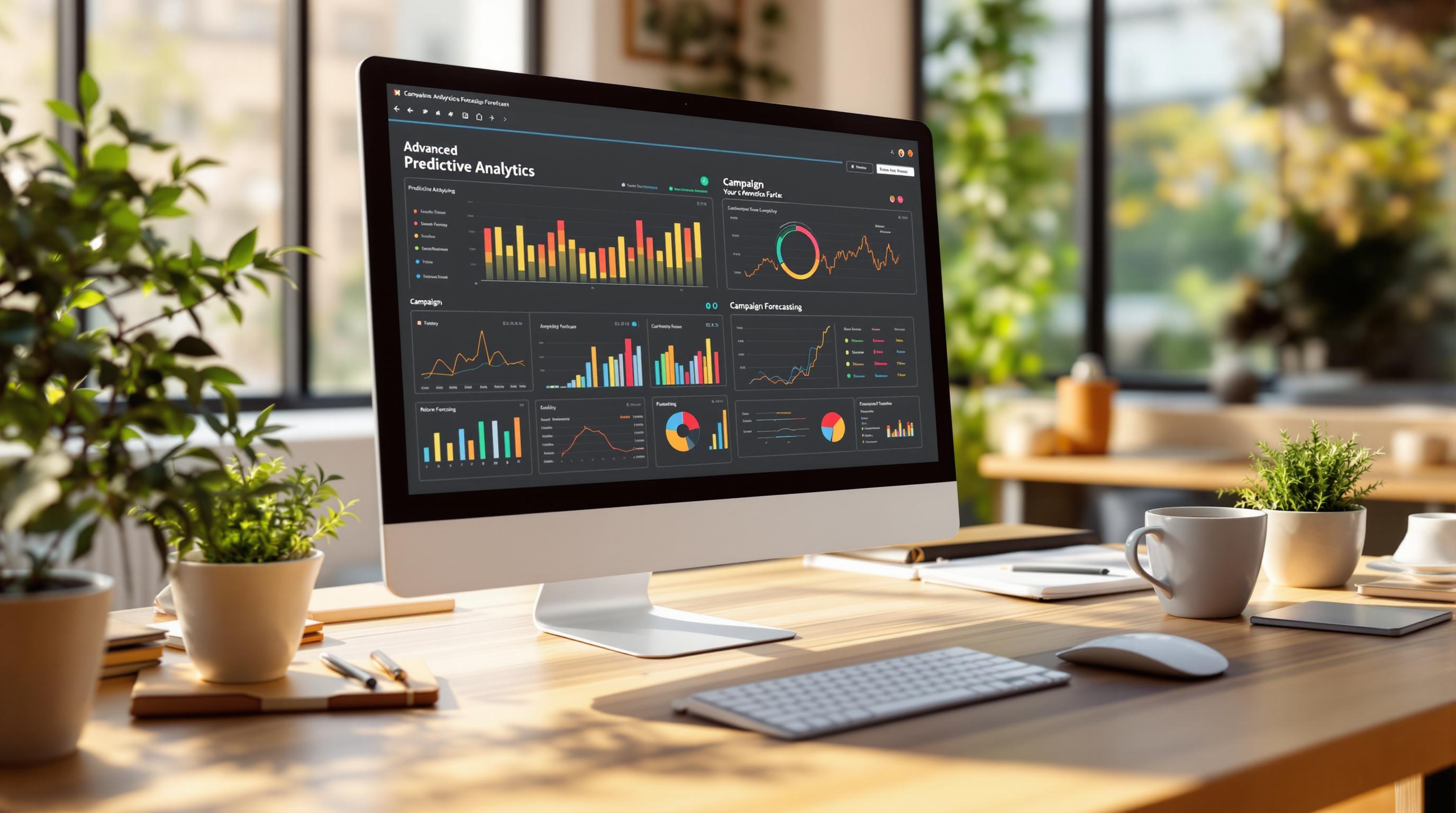Data analysis is key to making smarter marketing decisions. It helps you understand customer behavior, improve campaign performance, and boost ROI. Here’s a quick guide to get started:
- Key Skills: Learn KPIs, segmentation, data visualization, and critical thinking.
- Tools to Use: Google Analytics, Tableau, Excel, and SQL.
- Learning Plan: Start with basics, master tools like Google Analytics, and practice with sample data.
- Advanced Techniques: Dive into predictive modeling, cohort analysis, and machine learning.
Ready to apply these insights? Use data to refine marketing strategies, optimize budgets, and create successful campaigns. Let’s explore how to make data work for your marketing goals.
Key Skills and Concepts for Marketing Data Analysis
Important Terms and Metrics
Understanding terms like KPIs and segmentation is essential for making data-driven decisions. KPIs, or key performance indicators, are measurable goals aligned with business objectives. These are tracked using specific metrics, such as page views or conversions.
Here’s a quick overview of some core marketing analytics concepts:
| Concept | Definition | Business Application |
|---|---|---|
| KPIs | Strategic goals linked to business outcomes | Evaluating campaign success and ROI |
| Metrics | Specific data points used for measurement | Monitoring daily performance |
| Segmentation | Grouping audiences by shared characteristics | Tailoring marketing strategies |
| Data Visualization | Graphical representation of data | Simplifying complex datasets for clarity |
Accurate analysis starts with clean, well-organized data. With these basics covered, let’s dive into where marketers can find the data they need.
Where Marketing Data Comes From
Effective marketing analysis pulls from various data sources, each offering unique insights into customer behavior and campaign effectiveness. Below are some key sources:
- Website Analytics: Tools like Google Analytics reveal user behavior, traffic sources, and conversion rates, helping identify areas for improvement.
- CRM Systems: Customer relationship management systems track interactions, purchases, and preferences, enabling personalized marketing.
- Social Media Platforms: Social media data highlights engagement levels, content performance, and audience sentiment, shaping content strategies.
- Campaign Reports: These reports provide metrics on email campaigns, advertising performance, and conversion rates.
"At a minimum, marketing analysts should have experience setting up a test group and a control group, running an experiment and comparing the results."
For those new to analyzing these data sources, the Marketing Analytics Tools Directory is a great resource to explore tools and get started.
How to Start Learning Data Analysis for Marketing
Choosing the Right Marketing Analytics Tools
The tools you use can make or break your marketing analytics journey. A great starting point is Google Analytics, which is free, easy to access, and comes with learning resources and a Demo Account featuring real data from the Google Merchandise Store. The Marketing Analytics Tools Directory suggests evaluating tools based on three main factors: how they collect data, their analysis features, and their reporting capabilities.
Here’s a quick comparison of tools that are perfect for beginners:
| Tool Type | Best For | Key Features |
|---|---|---|
| Google Analytics | Website tracking | Free, detailed data collection |
| Tableau Public | Data visualization | Interactive dashboards, free access |
| Microsoft Excel | Basic analysis | Easy to use, widely available |
| SQL | Database queries | Handles large datasets efficiently |
Once you've picked your tools, the next step is to follow a structured plan to build your expertise step by step.
Step-by-Step Learning Plan for Beginners
1. Get Comfortable with the Basics
Start with foundational concepts like data types, basic statistics, and organizing marketing data using tools like Excel or Google Sheets. Spend 2-3 weeks honing these skills.
2. Learn the Technical Side
Dive into Google Analytics. Complete its certification courses over 4-6 weeks to understand vital metrics and reporting techniques.
3. Develop Visualization Skills
Focus on creating clear and actionable visualizations. Work with common metrics such as conversion rates, customer acquisition costs, and engagement rates to tell compelling stories with your data.
Practice with Sample Data
Hands-on experience is key. The Google Analytics Demo Account is a great resource for practicing. Use it to create dashboards that track:
- Customer acquisition channels
- Conversion rates by source
- User behavior flow
- Campaign performance metrics
When building reports, aim to answer specific business questions. For example, identify high-performing channels or analyze customer segments. These exercises will help you apply your skills to real-world marketing challenges and deliver actionable insights.
Understanding Digital Marketing Analytics
sbb-itb-5174ba0
Using Data Analysis to Improve Marketing Results
Once you've worked with sample data, it's time to use those insights in real-world marketing efforts.
Examples of Successful Campaigns
Here’s how data analysis has been used to achieve measurable success in different types of campaigns:
| Campaign Type | Key Metrics Analyzed | Results Achieved |
|---|---|---|
| Email Marketing | Subject line performance, open rates, click-through rates | Higher engagement |
| Social Media | Post timing, engagement patterns, audience behavior | Increased reach |
| Customer Segmentation | Purchase history, browsing behavior, demographics | Improved conversions |
Adding Data Analysis to Marketing Processes
Integrating data analysis into your daily marketing routine starts with a few essential practices:
- Regular Data Review Sessions: Schedule weekly meetings to assess key metrics like ROI and engagement rates. This keeps your team aligned and focused on performance goals.
- A/B Testing Framework: Test one variable at a time - like headlines or call-to-actions - to pinpoint what drives better results. Consistency is key here.
- Data-Driven Content Strategy: Use analytics to identify which topics resonate most with your audience, optimize publishing times, and monitor engagement across platforms.
- Budget Optimization Process: Keep a close eye on ROI, adjust spending based on performance, and use forecasting tools to predict future outcomes.
With marketing analyst roles expected to grow by 22% from 2020 to 2030, and e-commerce projected to account for 24.5% of global retail sales by 2025, data analysis is becoming a must-have skill for marketers.
Tools like Google Analytics and Tableau can simplify these processes. They help you track campaign performance, visualize trends, and make informed decisions. Ready to take it further? Let’s dive into advanced techniques and resources to sharpen your expertise.
Advanced Topics and Learning Resources
Advanced Methods in Marketing Analytics
Once you've mastered the basics, diving into advanced methods can sharpen your ability to predict outcomes and tailor strategies. For example, predictive modeling uses past data to estimate campaign results and ROI, helping marketers make smarter decisions. Similarly, cohort analysis tracks specific customer groups over time, providing insights into engagement patterns and ways to improve customer acquisition.
Machine learning also plays a key role in refining marketing approaches. Here's how:
| Application | Purpose | Business Impact |
|---|---|---|
| Customer Segmentation | Groups customers based on behavior | Creates more precise campaigns |
| Content Optimization | Forecasts how content will perform | Boosts engagement rates |
| Budget Allocation | Allocates spending based on ROI predictions | Maximizes resource efficiency |
Resources for Learning More
Looking to dive deeper? These platforms offer structured learning options:
| Platform | Focus Area | Best For |
|---|---|---|
| Coursera | Broad marketing analytics courses | Academic learning |
| LinkedIn Learning | Tool-focused, practical training | Building hands-on skills |
| Harvard DCE | Certifications in marketing analytics | Exploring advanced topics |
For practical tools, check out the Marketing Analytics Tools Directory. It covers a wide range of tools for real-time analytics, campaign tracking, and business intelligence - helping you pick the right ones for your needs.
To truly level up, focus on these technical skills:
- Python and Pandas for data analysis
- Advanced SQL for segmentation and trends
- Statistics for deeper insights
- Tableau for creating clear, impactful visualizations
With these advanced methods and resources, you'll be ready to tackle complex challenges and take your marketing expertise to the next level.
Summary and Next Steps
Key Takeaways
E-commerce sales are expected to make up 24.5% of all retail sales globally by 2025. To thrive in this growing market, marketers need to master data analysis skills. This means combining technical know-how with strategic marketing expertise to achieve impactful results.
Here are the core elements to focus on:
- Grasping essential analytics tools and key metrics
- Building the ability to make decisions based on data
- Using insights to refine marketing strategies
- Strengthening skills in visualization and reporting
Keep Improving Your Skills
Becoming proficient in data analysis takes ongoing effort and applying what you learn to real marketing scenarios. Tools like the Marketing Analytics Tools Directory can help you explore advanced options as you progress.
For faster improvement, concentrate on these areas:
- Mastering Tools: Dive deep into one tool at a time to build expertise.
- Data Storytelling: Practice presenting insights in a clear, compelling way.
- Strategic Alignment: Ensure your insights tie back to marketing objectives.
Set aside time each week to practice with sample datasets. This will help you gain confidence and experiment with new tools. Remember, success in marketing analytics comes from blending analytical skills with business insight. By sharpening your abilities and applying them thoughtfully, you’ll stay ahead in the competitive, data-driven marketing world.


